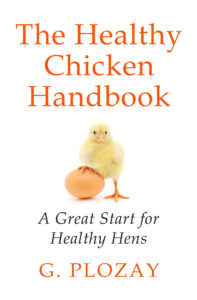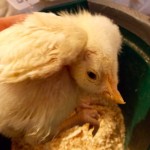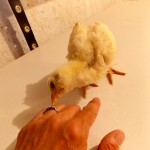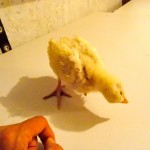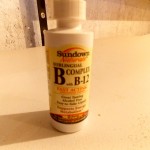Here are the facts:
- Pasture raised meat is a great source of Omega 3 fatty acids, carotenoids, vitamin E, vitamin A, and folic acid
- Pasture raised chicken has 50% more vitamin A and 100% more omega – 3’s than confinement raised birds
- Compared with commercial birds, pasture raised chicken has 21% less total fat, 30% less saturated fat, and 28% fewer calories.
- Under USDA guidelines breast meat from pasture raised chicken is so lean it earns the designation, “fat free.”
- Feeding a Family in a Hurry
- Quick, Healthy Meals
- Familiar Family Dinners
- Ground beef 22%
- Pepperoni (likely on pizza) 15%
- chicken breast 10%
- 25% Boneless chicken breasts
- 8% Rotisserie chicken
- 7% ground turkey and salmon
- 25% ground beef
- 17% Boneless chicken breast
- 5% pork chops
Is factory farmed chicken healthy?
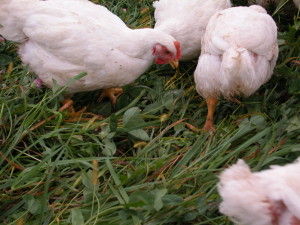
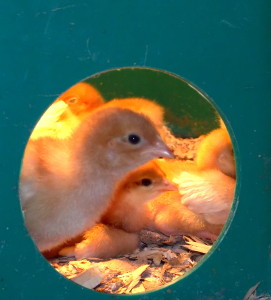 Making a Protein Tub Brooder for Starting Chicks
Making a Protein Tub Brooder for Starting Chicks
*This article appeared in Tractor Supply Company's, Out Here Magazine*
Murphy's Law of Farming states that, 'The minute your chicks arrive in the spring so will a cold front'. Making a protein tub brooder keeps chicks warm and healthy. A protein tub brooder is a more efficient solution than hanging brooder lights, and a protein tub brooder keeps the heat where it should be; surrounding the chicks. They also create a draft free area with plenty of ventilation.
For years we started chicks under hanging heat lamps. The electric bill reflected the inefficiency.
It's important to have more than one protein tub brooder in case the light in one of them burns out there's another warm area for the chicks.
Each protein tub comfortably houses 10 chicks.
If you're starting turkeys read this to prevent early poult flip over
Supplies:
- 2 recycled protein tubs or Two muck buckets
- 2 Brooder Light fixture with wire lamp guard
- Lightweight chain
- 2 *100-watt incandescent bulb or low-wattage heat lamp ( 1 for each bucket)
- Pine shavings
* Rough Service incandescent bulbs NOT LED or compact fluorescent
Tools:
- Black permanent marker
- sharp knife, jig saw, or drill with 4” hole saw
Instructions:
Wash the protein tub or protein tub.
Flip the protein tub over and trace the outline of the brooder light in the center of the bucket's bottom.
Use a sharp knife or jig saw to cut along the outline. Cut the opening slightly smaller than the outline so the brooder light sits securely on top of the bucket.
Next use a jig saw or drill fitted with a 4” hole saw to cut 3 openings, evenly spaced, around the outer edge (which will become the chick's access to the brooder). Cut the holes an inch above lip of the protein tub. It's important to cut more than one entrance to prevent crowding at the opening. Multiple entrances improve ventilation.
Flip the protein tub over. Hang the brooder lamp from a lightweight chain. The chain is for safety, it prevents the lamp from falling inside the brooder. The brooder lamp should fit snugly on top of the protein tub with the lamp and wire guard sitting inside.
Use a 100 watt incandescent bulb or a low-wattage heat lamp in the fixture. Do not use a compact fluorescent or LED light - they do not generate heat. NEVER use a high wattage heat lamp and Never use a heat lamp with straw!
Spread pine shavings throughout the brooder area, both inside and outside the protein tub, to a thickness of 3 inches. Nestle the buckets into the shavings so the chicks can easily enter and exit the protein tub brooder.
Place feed and water outside the protein tub brooder. The chicks will eat and drink freely and go inside the bucket when they need to warm up.
Before your chicks arrive turn on the lights so that it's a comfortable temperature; 95 degrees the first week, reduced by five degrees each week following. Reducing the temperature is as easy as changing the bulb; a 100 watt bulb (or low-wattage heat lamp depending on the temperature) the first week or two. Change to a 75 watt bulb as the outside temperature warms up. Use brooder lamps until the chicks feather out and the outside temperature is comfortable.
Conclusion
Making a protein tub brooder is an efficient way to keep your chicks warm and healthy. This type of brooder is economical and easy to make. A protein tub brooder will last for years.
On our organic farm getting the chicks off to a healthy start is the key to their successful transition into the pasture. We've experienced fewer losses with better growth rates after making this brooder a part of our poultry plan.
This is the Best Brooder for Starting Chicks!
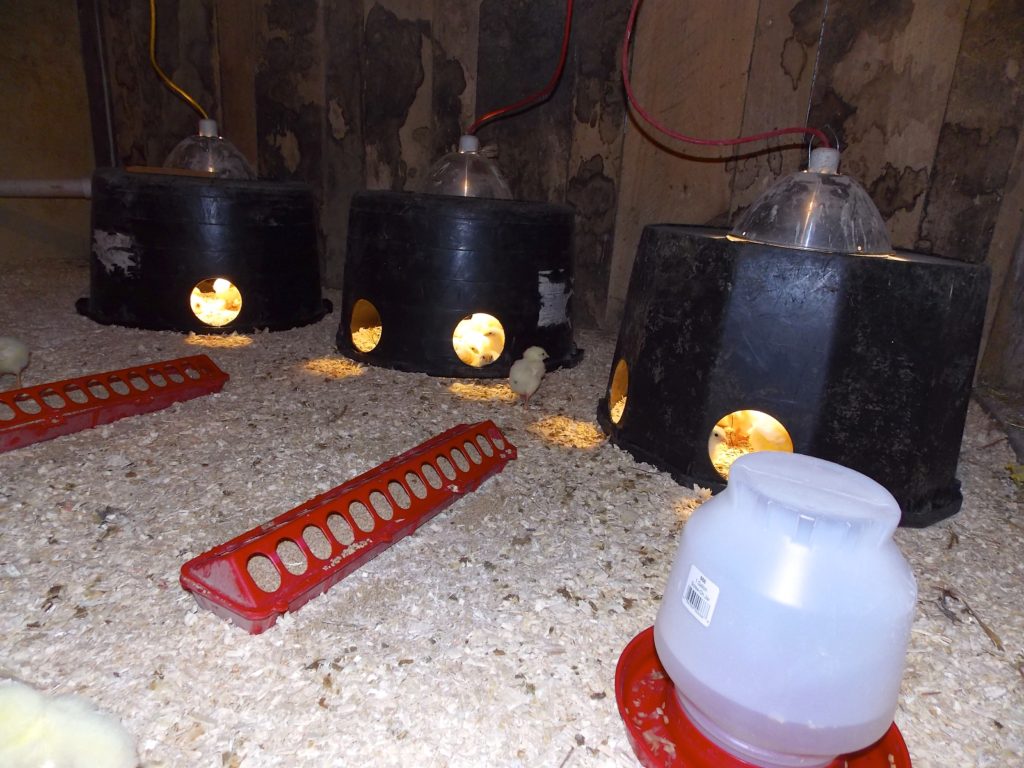
Need other great ideas for raising healthy hens?
Check out The Healthy Chicken Handbook
How to kill tens of thousands of chickens with the flip of a switch
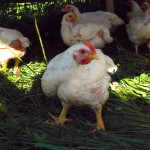 Clean living conditions prevent disease; Sunlight kills viruses, fresh greens boost immunity and exercise improves health. These are the benefits for poultry raised on pasture.
Clean living conditions prevent disease; Sunlight kills viruses, fresh greens boost immunity and exercise improves health. These are the benefits for poultry raised on pasture.
Inside poultry confinement buildings ventilation fans run 24 hours a day. Without these fans the birds die relatively quickly from ammonia fumes and the heat that’s generated from the high density of bodies within the building.
Secretary of Agriculture Tom Vilsack has announced that the federal government is preparing for a bird flu outbreak this fall that could be twice as bad as the one this spring.
The USDA is calling for shutting down the ventilation system if there's another outbreak of Avian Flu. The policy is designed to help farms more quickly keep the virus from spreading.
USDA officials said that teams hired to euthanize birds in Iowa and Minnesota fell behind on destroying infected birds this spring due to the size of the flocks. The new euthanasia policy initiates a 24 – hour “stamping-out.” If no other method of killing would meet the 24 hour deadline federal and state officials, along with the producer, agree to shut down the ventilation system.
For chickens in pasture it's a different story. There is no switch to flip. No ventilation fans to shut down. Just sunshine, fresh air and green grass. Pasture pens are open to allow chickens access to all three. The tops are partly covered to give shade along with protection from the rain. The bottoms are open to the grass. The birds aren’t crowded and they live outdoors during the optimum growing season; May – October.
Before dropping that carton of eggs or package of conventionally raised chicken into your grocery cart the next time you're at the store remember these words from Jo Robinson, author of Pasture Perfect;
“... a chicken that looks stressed and abused on the day of slaughter looks just fine when cut into uniform pieces and wrapped with plastic. The words on the label are targeted to calm any concerns one might have about the meat. This chicken is “Fresh, All-Natural, and Locally Grown!”
Instead of buying confinement chicken make a healthier decision. Find a farmer who raises pastured poultry. The health and taste benefits far surpasses the cost.
]]>
Every now and again we have a chick or a full grown hen whose neck and head are crooked. This particular chick was in the brooder when I noticed that she wasn't moving to the freshly filled feeder with the rest of the flock. Typically, as soon as the feeders are re-filled, the chicks crowd around them. I noticed her head was tilted on a sharp angle - almost upside down. I gave her a quick exam; she hadn't been smothered, crushed, or stepped on. I placed her in a small bucket with shavings to cushion her and got out the bottle of B-12 vitamins.
If you ever find one of your poultry with this condition here are the steps to follow:
- Get B-12. Sublingual drops.
- Use an eye dropper to administer B-12 (Do not use the dropper that comes with the B-12, you don't want to contaminate the bottle with bacteria)
- poured some of the B-12 out on a dish, used an eye dropper or syringe (without the needle) to draw up the vitamins. A few drops are more than enough for a chick.
- Tilt back the chicks head, open up the beak and squeeze in the drops. Make sure the chick swallows them.
- Don't use more than a few drops, we're trying to heal, not drown, the chick.
- Keep her in a small box or container that's open on top and place it in a safe area where dogs, cats, or other chickens can't bother her.
- Repeat the drops three times a day for a couple days.
Every few hours you should see improvement. After one dose her head and neck should start to return to normal. Give the chick water in the same method as the B-12 a couple times a day and offer a small amount of feed free choice. If you don't have B-12 available try using raw liver. Chop the liver very fine or use a food processor to make a paste. Open the chicks beak and feed a small amount of liver. Massage the chicks throat to make sure she doesn't choke. Follow this with a few drops of water. Feeding liver will take longer to correct the crooked neck than the B-12 drops. You should see improvement within a couple of days.
]]>
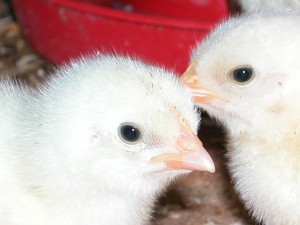
During the summer months our chickens follow the cattle and sheep through the pasture. They eat plants, seeds and insects. Among this group of hens was a Barred Rock rooster who we separated and moved into the timber. Later in the summer we were given a Buff Orpington rooster who was also moved into the timber. Late in the fall we brought the Buff Orpington rooster to the barn but he's been kept separate from the hens. We couldn't find the Barred Rock rooster, figuring that he'd become prey to an owl, eagle, or coyote, we dismissed his absence. When we were cutting wood a couple weeks ago we spotted him scratching up grain along the side of the road. He'd survived predators, freezing temperatures and a blizzard. One of our neighbors spotted him and tried to catch him. It was impossible and she declared him, 'Too independent for capture". A few days later Keith discovered him in the barnyard, strutting and crowing. When our son was on his daily run the rooster followed him but then turned into the timber. A few days later he was back in the barnyard again. This back and forth must have been ongoing. He's been making regular visits, or at least regular enough to court our hens. The turkey, acting as a surrogate, seemed very surprised herself.
There's something about getting up at 5 a.m., feeding the stock and chickens, and milking a couple of cows before breakfast that gives you a lifelong respect for the price of butter and eggs. - Bill Vaughan
There's one major problem with a turkey hatching chicken's eggs; she's too big for the chicks. They need to be able to free themselves from their shell and be kept warm without suffocating. A turkey hen is too heavy. She's designed to hatch her own eggs which are larger. Her poults are heavier. Also, the hayloft isn't the best environment for new chicks. They need food, water, and safety from falling out of the loft. The turkey is mad that we stole "her" chicks (but they're safe now). The turkey bonded with these chicks even before they hatched. While still in the egg the chick peeps through the shell and talks with the hen. When they hatch the chick recognizes the hen as it's mother. These conversations go on for about three days before hatching. If you ever have the opportunity to hatch chicks you'll be overjoyed to hear the soft chirps and peeps coming from the egg. It's a beautiful sound.
]]>